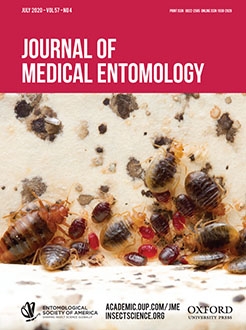Aedes albopictus (Skuse) was first reported in the Republic of Korea in 1941 (Suwon, Gyeonggi Province). Recently, a mosquito-monitoring program was established in response to the potential development of autochthonous infections of dengue, chikungunya, and Zika viruses, to identify the regional characteristics of Ae. albopictus in Suwon. Daily collections of adult mosquitoes were conducted using Blackhole UV-LED traps and BG-Sentinel traps baited with octenol, carbon dioxide or both at five sites in Suwon (Sungkyunkwan University, Manseok, Seoho, Olympic, and Jungang parks) from 1 July to 1 November 2016. Based on the ecological cycle of mosquitoes, an estimated association between the daily mean temperatures [2 wk prior to the collection date (lag 2 wk)] and relative population abundance were developed using a generalized linear model. The overall proportion of female mosquitoes collected from all traps was 88.3%. Higher female trap indices were observed for mosquitoes collected at BG-Sentinel traps. Additionally, the BG-sentinel trap was more effective collecting Ae. albopictus. Culex pipiens (Coquillett) was the most frequently collected mosquito using UV-LED traps, followed by Ae. vexans nipponii (Theobald), Ochlerotatus koreicus (Edwards), Cx. inatomi (Kamimura and Wada), and members of the Anopheles Hyrcanus Group. Within a certain temperature range, daily mean temperatures 2 wk prior to the collection period was significantly associated with a maximum abundance of Ae. albopictus (P < 0.05) at 26.2°C (95% confidence interval: 24.3–29.4°C).The BG-Sentinel trap is an effective trap for monitoring relative population abundance of Ae. albopictus, and trap catches are significantly correlated with daily mean temperatures.
How to translate text using browser tools
17 March 2020
Temporal Trend of Aedes albopictus in Local Urban Parks of the Republic of Korea
Myung-Jae Hwang,
Jong-Hun Kim,
Heung-Chul Kim,
Myung Soon Kim,
Terry A. Klein,
Juhwa Choi,
Kisung Sim,
Yeonseung Chung,
Yadav Prasad Joshi,
Hae-Kwan Cheong
ACCESS THE FULL ARTICLE
It is not available for individual sale.
This article is only available to subscribers.
It is not available for individual sale.
It is not available for individual sale.

Journal of Medical Entomology
Vol. 57 • No. 4
July 2020
Vol. 57 • No. 4
July 2020
Aedes albopictus
BG-Sentinel trap
time trend
UV-LED light trap
vector ecology




